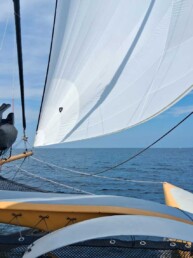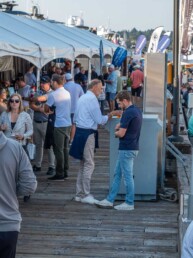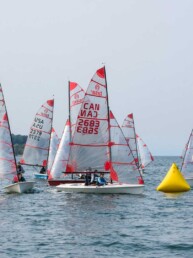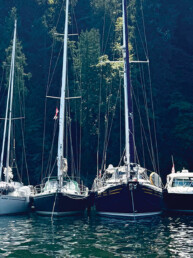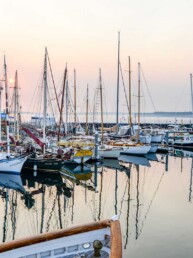One day before this magazine was sent to press, Seattle sailor David Linger crossed the finish line of the Global Solo Challenge in A Coruña, Spain, completing a solo sailing race around the world. I don’t know David well, but he was described to me by a friend as “one of the most competent sailors I’ve ever sailed with.” This page offers neither the format nor the space to appropriately honor David or his incredible accomplishment (we will be working on that in the near future). Still, David’s now-finished adventure illuminated some thoughts on a sailing truism: even in this age of connectivity, race trackers, and streamlined satellite communications, what happens on the water remains a magnificent mystery.
David is not someone who naturally seeks the spotlight, but I was able to talk with him before he departed and was excited about his trip and hoped to follow along. I even spoke to him as he was flying across the Southern Ocean when his girlfriend Lillian casually handed me the phone on the red carpets of the Seattle Boat Show; this happened only a few days before nasty seas broke his boom and forced him to pause his otherwise non-stop passage for repairs after rounding Cape Horn. In spite of ample opportunity, I admit that I just never found myself quite able to keep up with what was happening with David on the ocean. Certainly, others followed David’s journey and his posts with more dedication than I did, finding ever more inspiration in his endeavor. And yet, whether accessing his updates loyally or intermittently, the experience remains David’s, and the rest of us will really know it only as he wants to share it.
This reality ties modern day sailors to all voyagers throughout history, when these notions would have been self-evident. A vessel departed and, while the crew might remain front-of-mind for some shoreside family and friends, it was impossible to know much of anything about that boat and its sailors. Until very recently, information about a vessel’s whereabouts and well-being would have been delivered second or third or eleventh hand, if at all, with a significant time lag casting a long shadow of doubt over the details. Today, we often know vastly more—a boat’s location, its speed, its heading. We can learn about the weather conditions in its vicinity and whether there is other vessel traffic around. We may get updates via text, video or, as I discovered with David as he blasted towards Cape Horn, a real-time call.
Experienced sailors know this well, especially those who have sent such updates from remote places—in spite of best efforts and the array of available technology, the folks back home never get a very complete picture of what life is like for those on the water. You just have to be on the boat to truly understand. Even those on other boats with whom you’re sharing a particular patch of water are having a different experience. Zoom out even a little, and there are countless gaps to fill.
To me, it’s one of sailing’s many wonders, and reinforces the depth of relationships we build with our crewmates. Of course, at 48° North, we do our best to bring readers onboard and into the experiences of those sharing their stories. And yet, viewed from my editor’s desk, it is an inescapable fact that essentially all of the most incredible sailing on record has taken place far from the public eye, and even further from authentic public understanding.
If that isn’t a dose of springtime encouragement to get out and enjoy your own adventures, I don’t know what is! Please tell us about it when you get back to shore. And for now, enormous congratulations to David on his remarkable journey—we will look forward to hearing more from this local solo circumnavigator.
I’ll see you on the water,
Joe
Feature photo courtesy of Marco Nannini and the Global Solo Challenge.
Joe Cline
Joe Cline has been the Managing Editor of 48° North since 2014. From his career to his volunteer leadership in the marine industry, from racing sailboats large and small to his discovery of Pacific Northwest cruising —Joe is as sail-smitten as they come. Joe and his wife, Kaylin, have welcomed a couple of beautiful kiddos in the last few years, and he is enjoying fatherhood while still finding time to make a little music and even occasionally go sailing.

